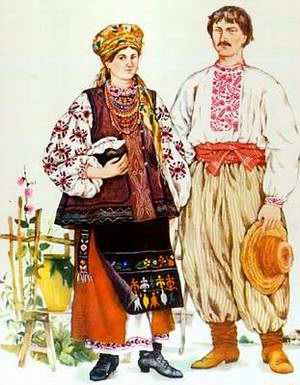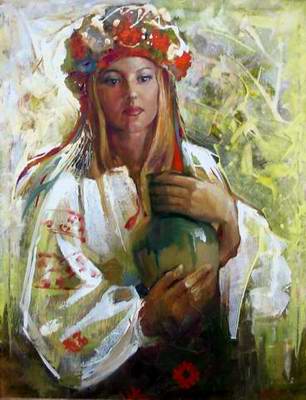Ukrainians - Overview
Ukrainians (before the beginning of the 20th century such names as “Little Russians”, “Rusyns” and “Cossacks” prevailed) are the East Slavic people live mainly in Ukraine, as well as in large diasporas in Russia, the USA, Canada, and other countries.
This ethnos formed on the lands of present Ukraine and parts of adjacent lands of present Poland, Belarus, Moldova, Romania, Hungary, Slovakia, and Russia. Among the Slavic peoples, it is the third in number after Russians and Poles. All citizens of Ukraine are also called Ukrainians.
The total number of Ukrainians in the world exceeds 46 million people, more than 37 million people live in Ukraine. Most speak the Ukrainian language belonging to the East Slavic language group and consider themselves Christians.
Ukrainians in traditional clothes

Ethnonyms of Ukrainians
Until the 19th century, the self-names of Ukrainians were “Rus” and “Rusyns” derived from the name of the medieval Russian state of Kievan Rus (882-1240). These names appear in chronicles, religious and secular literature of the 13th-19th centuries.
In the Latin texts, Rusyns were often called “Ruthenes”, in Greek sources and derived from them - “Russians”. In the literature of that time, “Rusyns” were opposed to Lithuanians, Poles, and “Muscovites” (present Russians).
In the 16th-19th centuries, in parallel with the name “Rusyns”, Ukrainians were also called “Cossacks”. This was due to the fact that Ukraine was the center of The Zaporozhian Sich - a semi-autonomous polity of Cossacks that existed in the 16th to 18th centuries.
From the end of the 17th to the beginning of the 19th century, after most of Ukrainian lands became part of the Russian state, Ukrainians were also called “Little Russians” (“Malorossy”) because of the Byzantine church name of Ukraine - “Little Russia”.
The ethnonym “Ukrainians” was first mentioned in the documents devoted to The Nalyvaiko Uprising at the end of the 16th century. In the first half of the 17th century, the ambassadors to the Diet of the Commonwealth from the Kyiv, Bratslav and Chernihiv voivodeships were called Ukrainians.
From the beginning of the 19th century, in order to emphasize its separation from Russians (“Velikorossy” - “Great Russians”), Ukrainian intelligentsia in Kharkiv began using the name “Ukrainians” as a common ethnonym in place of the old name “Rusyns”.
This name was finally established after the Ukrainian national liberation movement of 1917-1920 and Soviet Ukrainization. The same thing happened in Galicia and Bukovina in 1918-1940 in connection with the activities of Ukrainian nationalist organizations.
Ethnic Territory of Ukrainians
The Ukrainian ethnic territory is the second largest in Europe after the Russian ethnic territory covering about 600 thousand square km and extending approximately 1,400 km from west to east by a wide strip (from 300 to 700 km).
In the border areas of Ukraine, on the Crimean peninsula, as well as in a number of areas adjacent to Ukraine, there are territories with a mixed ethnic structure of the population. The Ukrainian ethnic territory borders on the ethnic territories of Russians, Byelorussians, Poles, Slovaks, Hungarians, Romanians, Moldovans.
The greater part of the Ukrainian ethnic territory has a monoethnic population, where Ukrainians make up more than 80%. Such territories prevail in 22 regions of Ukraine. In the Lugansk region they make up about 50% of the territory, in the Donetsk region - up to 25%. Ethnic Russians make up about 17% of the country’s population.
Ukrainian girl in traditional clothes

Other Interesting Facts
A significant part of Ukrainians speak Russian or the so-called Surzhyk (a mix of Ukrainian and Russian languages) because of the Russification of Ukrainian lands in the 19th-20th centuries. Also some people living in Ukrainian Galicia, Bukovina and Transcarpathia know Polish, Romanian and Hungarian.
Ukraine has a certain population imbalance. In 2013, there were 46.2% of men and 53.8% of women (mostly the result of the Second World War). Among the urban population, men make up 45.8%, women - 54.2%, among the rural population - 47.0% and 53.0% respectively.
As of January 1, 2016, the urban population was about 69%, rural - 31%. Eastern Ukraine, especially the Donetsk and Lugansk regions, is much more urbanized than Western Ukraine.
The average age of the population of Ukraine is 40.6 years: men - 37.4 years, women - 43.7 years. From 1989 to 2013, the average age of the population of Ukraine increased by 4 years. This process was particularly rapid in the urban population, where the average age increased by 5.6 years.
In 2017, the expected life expectancy in Ukraine was 72.1 years, men - 67.4 years, women - 77.1 years.



